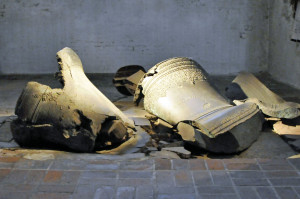Henry the Lion, a powerful German prince, founded Lübeck in 1159 on an island surrounded by rivers linking the German interior to the Baltic Sea. By the 13th century, Lübeck, with a population of 25,000, had grown rich trading such items as fish, wood, and salt. Controlled by local merchants, the town put its wealth into imposing buildings, from glazed-brick city gates and a monumental town hall to five churches boasting a total of seven spires. Lübeck’s grandest architectural achievement was twin-towered St. Mary’s Church, erected adjacent the town hall from 1250 to 1350. Lacking sandstone, builders executed in brick the Gothic style becoming popular further south, creating what remains, at 126 feet, the world’s tallest brick vault. The design of St. Mary’s inspired dozens of imitators around the Baltic. By the 15th century, Lübeck was the “Queen City” of the Hanseatic League, an alliance of northern European market towns.
In the early morning hours of March 29, 1942, Palm Sunday, 234 Royal Air Force bombers attacked Lübeck in the first substantial air raid on a German city. Buildings were set afire by a combination of blockbuster bombs and incendiary devices. About 20 percent of the town was destroyed and 301 residents were killed in the resulting firestorm. Three of Lübeck’s ancient churches were severely damaged. Bells hanging in the 410-feet high towers of St. Mary’s reportedly rang out as they fell into the blazing church.
Visitors to Lübeck, a UNESCO World Heritage site, can walk up a curving cobblestone street from the single remaining town gate to the old town center, passing gabled townhouses of 13th century merchants. The most significant medieval structures have been meticulously restored, with one notable exception. The shattered bells of St. Mary’s lie in a small corner chapel, just as they alighted, a reminder that war’s devastation respects neither religion nor history.

Comments are closed.